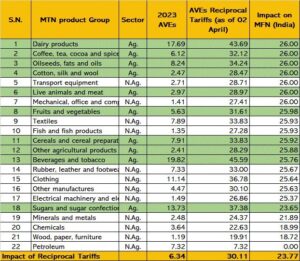
Impact of US tariffs: The much-dreaded Liberation Day, Washington’s euphemism for a sweeping wave of tariffs, finally arrived on April 2. As anticipated, India found itself on the receiving end, with a 26% tariff slapped on its exports to the United States. The move has raised serious concerns about the future of trade ties between New Delhi and its largest export destination.
In a dramatic shift from traditional diplomacy, President Donald Trump announced that the US would impose tariffs equal to half of what other countries charge on American goods. Since India levies a cumulative 52% tariff on US products, the new White House annexure listed a reciprocal 27% tariff on Indian goods.
But this is only the beginning. According to a White House fact sheet, a 10% base tariff on all imports will take effect from April 5. From April 9, countries running the highest trade deficits with the US — including India — will face even steeper levies. A total of 185 countries are expected to be impacted. With these moves, the average US tariff rate has now surged to 29% — its highest level in over a century.
READ | Ayushman Bharat: A grand promise undone by poor execution
Blow to India’s export ambitions
The fallout for India is likely to be significant. The US is one of the few major economies with which India enjoys a trade surplus — $46 billion as of 2024. However, these gains now stand threatened.
India had already been in Washington’s crosshairs, featuring in Trump’s infamous Dirty 15 list — countries deemed the worst offenders in terms of trade practices. The sectors expected to be hit hardest include agriculture, pharmaceuticals, chemicals, and precious stones.
Trump effect: Additional US tariffs on India

According to a recent study by the Global Trade Research Initiative (GTRI), the most affected agricultural segments will be fish, meat, and processed seafood — which together accounted for $2.58 billion in exports to the US last year. Notably, America absorbs 40% of India’s total shrimp exports. Higher tariffs will erode competitiveness and shrink market share.
India’s gains in electronics could also unravel. The Indian government had worked to position the country as a viable alternative to China under the China+1 strategy, especially in smartphone manufacturing. Finished smartphones currently attract a 16-20% import duty in India, while Indian exports to the US enjoy zero duty. But if US tariffs now apply to Indian phones, the fledgling sector may suffer a blow in its early growth phase, potentially reversing hard-won progress.
One silver lining, however, is that India’s IT services — which form a large chunk of exports — are exempt from goods-specific tariffs, at least for now.
Navigating a rising trade storm
The pressing question for India’s policymakers is: how to counter mounting trade pressure from Washington without derailing its export-led growth strategy?
A crucial step would be to fast-track the ongoing negotiations for a Bilateral Trade Agreement with the US. Talks have been in motion, and both sides have incentives to reach an accord quickly. A successful BTA could offer exemptions or relief from some of the punitive measures.
India has already taken pre-emptive steps. In March, New Delhi signed the terms of reference for a BTA following a push from the Prime Minister’s Office. It also lowered duties on select American products — including high-end motorcycles, agricultural goods, and Bourbon whiskey — in its Union Budget, signalling a willingness to negotiate.
Still, New Delhi must tread carefully. While India’s tariff levels may appear high, they reflect domestic development goals and the need to protect vulnerable industries. The US prioritises its commercial interests. India too must evaluate each demand against its own national priorities — development, industrialisation, and cultural values.
A recent PwC report recommended that Indian businesses build long-term resilience strategies — including diversification of markets and value chain upgrades — to mitigate the impact of US protectionism.
Strategic realignments
Amid this backdrop, an intriguing diplomatic overture emerged. On April 2 — coinciding with the US tariff announcement — China and India marked the 75th anniversary of their diplomatic ties. Chinese President Xi Jinping, in a message to Indian President Droupadi Murmu, called for a “dragon-elephant tango” to strengthen cooperation. Prime Minister Narendra Modi echoed the sentiment, noting that stronger India-China ties would support a stable, multipolar world.
Observers see this as a subtle signal to Washington: major developing economies are willing to explore alternative alliances if pushed too hard. Xi emphasised the need for mutual modernisation between China and India as leading voices of the Global South — perhaps suggesting a pivot away from overreliance on Western markets.
The road ahead
The 26% reciprocal tariff may compel India to re-examine its own tariff structures, not just in response to the US, but to remain competitive in global markets. The coming weeks will be critical as New Delhi awaits a formal list of US demands and considers its options.
India remains an essential market for US companies across sectors — from tech to pharmaceuticals — and this mutual interdependence offers room for compromise. India’s strategy should be to engage the US in negotiations rather than escalate into a full-blown trade war.
As noted in a Bernstein report, India’s measured, diplomatic approach could help it navigate the turbulent waters of trade protectionism, preserving both economic stability and strategic autonomy.
